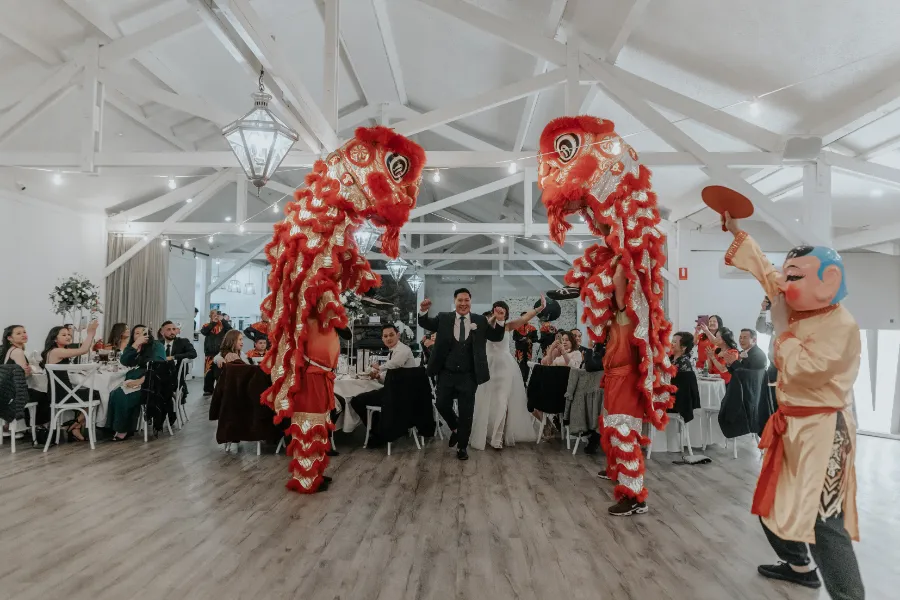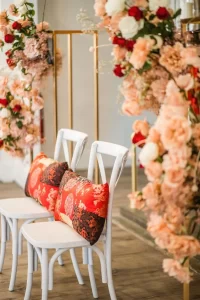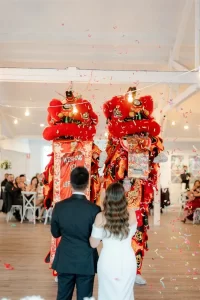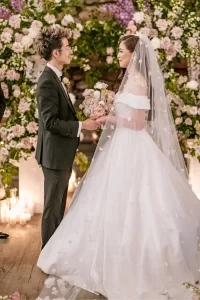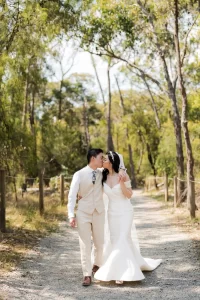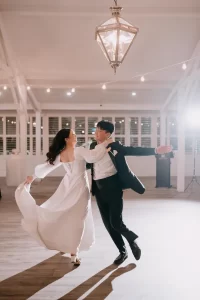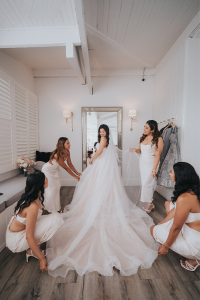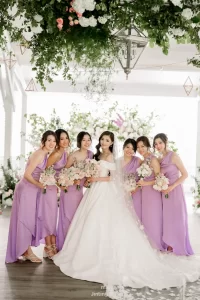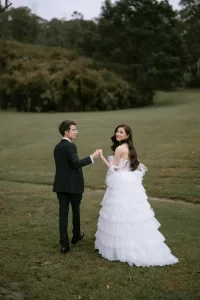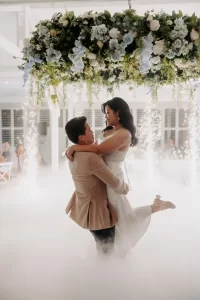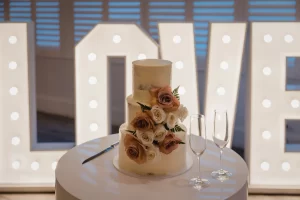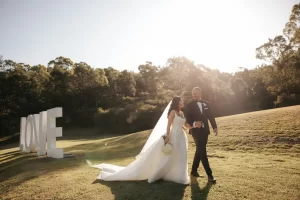Chinese weddings are rich with symbolism, steeped in tradition and filled with meaningful rituals that reflect deep cultural values – particularly around family, respect, and harmony.
From the moment the wedding is proposed to the final banquet celebration, every step of a Chinese marriage carries significance. While the practices can vary across regions and families, many core elements are shared and cherished to this day. Read on to find out more!
Why are Chinese Wedding Traditions Important?
Chinese wedding traditions and the customs of China play a huge role in shaping a Chinese wedding ceremony. From the reverent tea ceremony symbolising respect for elders, to the beautiful red Chinese wedding decorations symbolising happiness and good luck, every aspect of a Chinese wedding holds deep meaning.
In Melbourne, there is a plethora of wedding venues that claim they cater to these specific traditions. But finding the perfect venue that can actually accommodate all the necessary rituals and customs is crucial to ensure a meaningful and culturally rich wedding experience for both the couple and their families.
Wedding planning for a Chinese marriage involves a careful consideration of not just the aesthetics and logistics of the venue. You must also consider how well a venue can facilitate and support your important Chinese rituals, whilst also embracing the style of a modern wedding you are seeking.
Choosing an Auspicious Wedding Date
In Chinese culture, choosing an auspicious wedding date is considered one of the most important first steps in planning a Chinese marriage. The marriage date is believed to directly influence the couple’s future happiness, harmony, and prosperity. Families often consult the Chinese lunar calendar or seek guidance from a fortune teller or feng shui master to choose a good wedding date. Finding a marriage date that aligns with the bride and groom’s zodiac signs, birth dates and family traditions is particularly important.
Auspicious dates on the Chinese calendar are chosen to avoid any clashing elements and to ensure good fortune. Once the perfect date is selected, it becomes the foundation for all other wedding preparations, including sending out the wedding invitations. Invitations are often distributed with great care, ensuring that they reflect the selected marriage date’s positive energy.
Inauspicious dates – often linked to bad omens or unlucky numbers – are carefully avoided. This practice reflects the deep-rooted Chinese belief in balance and cosmic harmony. It’s a beautiful example of how ancient rites still play a meaningful role in modern Chinese weddings.
The Marriage Proposal Ceremony
One of the earliest stages in the series of Chinese wedding customs is the betrothal or ‘Guo Da Li’ marriage ceremony. During this important event the groom’s family presents a series of symbolic gifts to the bride’s family.
These betrothal gifts, which might include tea, wine, candles, and jewellery, signify respect, sincerity and a promise of a stable future. It’s a formal acknowledgement of the union and an important step in building harmony between the two families.
The Chinese Dowry or ‘Bride Price’
The dowry is a significant traditional practice in many Chinese weddings, though its role has evolved over time.
Historically in China the dowry was provided by the bride’s family to the groom’s family as a way of securing the marriage. The dowry would also ensure the bride’s financial security in her new home. It was often composed of valuable items like gold, jewelry, property, or even livestock. This tradition was deeply linked to the idea of family status and financial stability, as the dowry helped demonstrate the prospective bride’s worth and the bride’s family’s wealth to the groom.
In modern China, however, the concept of the dowry as part of Chinese wedding rituals has shifted. While some families of modern brides may still exchange a dowry as part of the marriage arrangement, it has become more symbolic. Many modern couples use the term to refer to gifts or monetary contributions that go towards the wedding costs or home setup.
The concept of a dowry may seem outdated and so is seldom used in real weddings in Australia. Despite this the dowry continues to reflect the importance of family bonds, respect for tradition and the bride’s value in the context of marriage.
The Traditional Chinese Tea Ceremony
Traditional tea ceremonies hold great significance in Chinese wedding traditions and are often held straight after the wedding day. The ceremony is a symbol of respect and gratitude towards the groom’s family, as the newlyweds pour tea for their relatives as a way to show their appreciation.
The tea is typically served with two lotus seeds or red dates, signifying fertility and harmony in the marriage.
The groom’s family is served in a specific order, starting with the eldest relatives and moving down to the younger ones.
After each family member has taken a sip of tea, they offer the bride and groom a red envelope containing money or jewellery. This time-honoured tradition not only strengthens family bonds but also brings good fortune to the newlyweds as they embark on this new chapter of their lives together.
Chinese Wedding Banquet
In traditional Chinese weddings, it was common for the bride’s and groom’s families to host separate wedding feasts – each side celebrating with their own community. Over time, this has evolved so that many modern ceremonies now see both families coming together to co-host a single, vibrant Chinese banquet.
These banquets are often lavish affairs, marked by joy, plenty of colour, and a deep sense of family pride. A typical wedding banquet features anywhere from five to ten elaborate courses, each dish chosen for its symbolic meaning. Examples include fish for prosperity, noodles for longevity, and sweet lotus seeds to bless the couple with fertility and many children.
But the banquet isn’t just about the food; it’s a key moment of celebration, gratitude, and connection. Speeches, toasts, games and multiple outfit changes by the bride are all common. It’s also a chance for the newlyweds to formally thank their guests, moving from table to table with a toast of ‘ganbei’ (cheers) to show their appreciation.
Even in weddings that lean more towards Western customs with white dresses, formal vows, or smaller guest lists, the wedding banquet is usually lovingly preserved. It’s seen not just as a cultural wedding tradition, but as a meaningful way to honour family, heritage and the joy of bringing two families together.
Chinese Wedding Photo Albums
One unique aspect of modern weddings in China is the tradition of taking wedding photos before the actual ceremony. Unlike Western weddings, where the big photoshoot typically happens on the day itself, Chinese couples often schedule a full pre-wedding photo session weeks or even months in advance.
These photoshoots are a major event in their own right, with couples dressing in multiple outfits, including traditional Chinese attire and modern formalwear. The photos are usually taken in a range of picturesque settings. These settings range from scenic outdoor locations and historic landmarks to elaborately decorated photo studios designed to mimic castles, gardens, or vintage interiors.
These carefully curated images are then compiled into a beautifully designed wedding album, which is proudly displayed at the wedding banquet for guests to browse and enjoy. It becomes both a conversation piece and a way to share the couple’s journey with friends and family.
While the pre-wedding photos are the star of the show, some couples still opt to have photographers or videographers capture the ceremony and banquet as well. Especially as in modern, more relaxed weddings a couple may want to preserve those spontaneous, emotional moments that often occur during this part of the wedding day.
This tradition reflects the importance of presentation and storytelling in Chinese culture. The wedding isn’t just a one-day event but a celebration of identity, aesthetics, and legacy. It also gives couples the chance to slow down and enjoy the moment, without the rush and pressure of a same-day shoot.
Bridal Outfit Changes
One of the most exciting and visually stunning aspects of a Chinese wedding is the bride’s multiple outfit changes throughout the day. In many Western weddings the bride typically wears one dress for the entire event. In contrast, Chinese brides often prepare several looks to showcase during different stages of the celebration, especially during the banquet. It’s not unusual for a bride to wear three to five different dresses over the course of the day. Each outfit represents a unique blend of tradition, modern elegance, and personal style.
The day often begins with the bride wearing a traditional qipao (also known as cheongsam) or a two-piece kwa. The qipao is an intricately embroidered red outfit often adorned with symbols like dragons and phoenixes that represent prosperity and harmony. This is usually worn during the tea ceremony and other formal family rituals.
For the ceremony or banquet entrance, many brides switch to a white Western-style wedding gown, embracing a more contemporary bridal look. As the banquet progresses, she may change into one or two more evening gowns, often in rich, vibrant colours like gold, blue, or burgundy, symbolising wealth, elegance, and celebration.
These outfit changes aren’t just for show, they represent the bride’s transition into different roles throughout the day: from dutiful daughter and respectful bride, to glamorous hostess and finally, joyful newlywed.
The bridesmaids often help with the outfit changes, assisting the bride to stay on schedule and offering emotional support as part of the wedding’s larger bridal procession. It also gives her the opportunity to honour her cultural heritage while expressing her individuality and personal taste.
On the wedding day, the bride is typically escorted by bridesmaids and close family members, symbolising her transition from her family home to a new life with her groom. The bridesmaids and family play an important role during this bridal procession, showcasing their support for the bride as she enters into this new chapter of her life with her groom.
Red Envelopes and Wedding Gifts
In Chinese culture, gift-giving plays an essential role in marriage, and one of the most beloved traditions is the giving of red envelopes, known as hongbao. The red envelope, symbolising good luck and prosperity, is typically filled with money and given to the newlyweds as a gesture of blessing the everlasting marriage.
The amount of money inside varies depending on the closeness of the relationship and regional customs. The amount is always even though. An odd number is avoided because it’s considered unlucky, as odd numbers are associated with funerals. The red envelope’s significance is profound: it’s not just about the monetary value but also the symbol of good wishes for the couple’s future happiness, prosperity, and fertility.
During the tea ceremony, the bride and groom often serve tea to their elders, who offer blessings and hongbao in return. These exchanges usually take place before the ancestral altar, where the couple honors their ancestors and seeks their blessing for a prosperous union. These envelopes may be decorated with Chinese characters that carry auspicious meanings, such as 福 (fú) for good fortune or 喜 (xǐ) for happiness, adding an extra layer of symbolic significance to the exchange. The hongbao is a symbol of respect, love, and goodwill.
Beyond the hongbao, wedding gifts are also given. These gifts can range from household items to more personal, luxurious presents. In recent years, gift registries have become more common, where couples can choose their desired items in advance. But regardless of the gift, the focus remains on practical items that will help the newlyweds start their life together, reinforcing the cultural importance of family support and harmony.
Modern Twists on Traditional Weddings
While Chinese weddings are deeply rooted in tradition, many modern couples are blending these time-honoured practices with Western influences and their personal preferences. Today, modern Chinese weddings often include elements like Western-style ceremonies with vows, rings, and a white wedding dress, combined with traditional rituals like the tea ceremony. This fusion allows the groom and bride to honour their heritage while embracing the globalised world they live in.
In some cases, the ceremony takes place in the home, where the bride and groom may offer their respects at the family altar. This personal, spiritual space is a place where ancestral tablets are kept and prayers are offered. The family altar serves as a reminder of the importance of family history and respect for ancestors, which is deeply ingrained in Chinese culture.
In terms of wedding locations, destination weddings have become increasingly popular. Young couples often choose scenic or exotic locations, both within China and abroad, to celebrate their union. These weddings may still include traditional wedding customs like the tea ceremony or red envelopes, but they often take place in a more intimate or relaxed setting, with fewer guests. Whether it’s a beach wedding in Bali or a countryside retreat, the destination wedding gives both the bride and groom the opportunity to create a unique and memorable experience.
As weddings become more global and couples embrace destination weddings or modern venues, the essence of these traditions remains strong. Honoring ancestors, family, and the union of two families will always be a focal point for a Chinese wedding, even if the family altar or ancestral customs are adapted to new settings.
Personalisation is another trend that has become prevalent in modern Chinese weddings. Couples now often incorporate personal touches into their ceremonies—customised wedding vows, unique decor inspired by shared memories, or creative photo shoots that reflect their personalities. Some even mix traditional Chinese wedding elements with modern themes, such as incorporating trendy floral arrangements and contemporary table settings alongside traditional foods and attire.
For many couples, technology also plays a role in their modern wedding. Live-streaming the ceremony for distant relatives or social media sharing of the event are popular. Some weddings also include wedding websites where guests can RSVP and see the couple’s love story unfold.
In these ways, a modern Chinese wedding ceremony continues to honour cultural traditions while reflecting the individuality and global influences of the bride and groom. It’s a beautiful balance of the old and new, where respect for family and heritage meets creativity, personal expression and new trends.
Gorgeous Chinese Weddings at Bramleigh Estate
Whether you’re looking to hold a traditional tea ceremony to honour your ancestors or decorate your reception area in red and gold, we can help. Our wedding specialists at Bramleigh Estate are here to make your traditional Chinese wedding an unforgettable and stress-free celebration.
With a stunning outdoor ceremony location and a stylish Chinese wedding venue space, we can help create an unforgettable day that combines modern luxury with your important Chinese cultural traditions.
Contact our team at Bramleigh Estate to book an inspection of our award-winning venue today.
You May Also Like…
Edible Artistry – Wedding Cake Inspiration
Join us as we dive into wedding cake wonderland and explore current trends and unique [...]
In Search of Perfection – Choosing a Wedding Reception Venue
Your soul mate has just popped the question, you have the bling to prove it, [...]
Free Wedding Venue Comparison Checklist
Having a wedding day wish list and clear priorities makes it easy to compare venues. [...]

